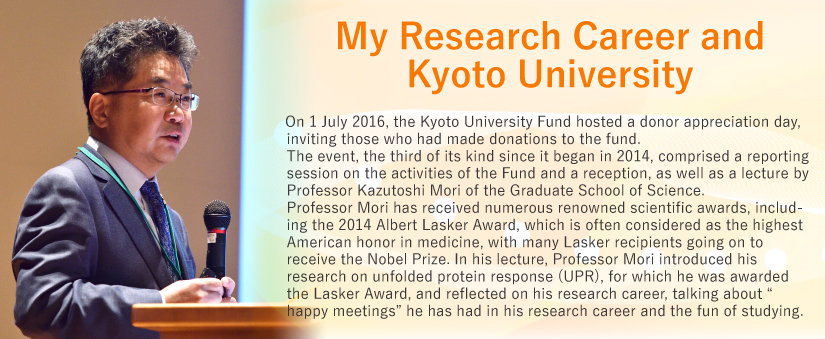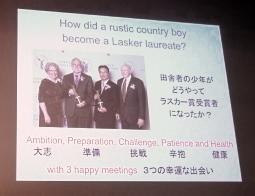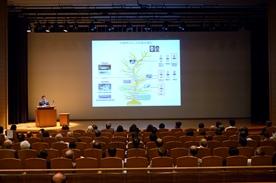Vol.5 Message from the Faculty

Kazutoshi Mori Professor at the Graduate School of Science
Kazutoshi Mori was born in 1958 in Kurashiki City, Okayama Prefecture. He graduated from the Faculty of Pharmaceutical Sciences, Kyoto University in 1981, and completed the Master's Program at the Graduate School of Pharmaceutical Sciences, Kyoto University in 1983. In 1985, he withdrew from the Doctoral Program at the Graduate School of Pharmaceutical Sciences, Kyoto University. He earned his Doctoral Degree in Pharmaceutical Sciences from Kyoto University in 1987. In 1985, he was appointed as Assistant Professor at Gifu Pharmaceutical University. He then went to the United States, where he became a Doctoral Fellow at the University of Texas in 1989. After returning to Japan, he assumed the post of Deputy Research Manager in 1993 and Research Manager in 1996 at the Heat Shock Protein (HSP) Research Institute. He was appointed as Associate Professor at the Graduate School of Biostudies, Kyoto University in 1999. In 2003, he was appointed as Professor at the Graduate School of Sciences, Kyoto University, which is his present post.
Awards and honors
1997 Young Investigator Award, Japanese Biochemical Society
2005 4th Wiley Prize in Biomedical Sciences
2006 1st Samuro Kakiuchi Memorial Award, Japanese Biochemical Society
2008 26th Osaka Science Prize
2009 Canada Gairdner International Award
2010 Shiju Hosho (Medal of Honor with Purple Ribbon)
2012 Uehara Prize
2014 The Asahi Prize, Shaw Prize in Life Science and Medicine, Lasker Award*
2015 Thomson Reuters Citation Laureate Certificate
2016 Imperial Prize and Japan Academy Prize
※Lasker Award
Officially the Albert Lasker Award for Basic Medical Research. This award, dubbed the "American Nobel Prize in Physiology or Medicine," is considered one of the United States' most prestigious medical prizes. So far, seven Japanese researchers have won the Lasker Award, including Dr. Susumu Tonegawa and Dr. Shinya Yamanaka, both of whom later became Nobel Prize laureates.
Five Elements Necessary to Realize
Your Dreams and His Three Happy Meetings
Professor Kazutoshi Mori has many opportunities to deliver lectures. He cited the following five elements necessary to realize your dreams: Ambition, Preparation, Challenge, Patience and Health.
According to the professor, everything begins with having an ambition, and to realize it, we should make preparation and take on challenges, which sometimes require patience. He also noted that all of these are possible only when we are in good health physically and mentally.
Professor Mori continued, "In addition to the above five elements, I would like to talk about the three happy meetings that changed the direction of my career as a researcher.
When Professor Mori was in elementary school, he was a science-loving boy who wanted to become a scientific researcher. It was the first ambition he had entertained in his life. At that time, he gained scientific knowledge from newspapers. It was particle physics that first attracted his interest. When quarks was a hot topic of conversation, he had a simple question: whether a quark, which is an elementary particle and a fundamental constituent of matter, is also made of further smaller particles or not.
In 1973 when he was a third year student at junior high school, Dr. Makoto Kobayashi and Dr. Toshihide Masukawa predicted that there would be six types of quarks in total. Their theory was proved correct later, and both doctors were awarded the Nobel Prize in Physics.
Professor Mori said that "Dr. Hideki Yukawa, the first Japanese Nobel Prize winner, and Dr. Shinichiro Tomonaga, the second Japanese Nobel Prize recipient, are both graduates of the Faculty of Science of Kyoto University. Upon learning this fact, I wanted to enroll at the same faculty as these Nobelists to study physics there."
It was the second ambition for Professor Mori. However, as a third-year student of high school, he found it difficult to achieve. When he worked on a collection of previous questions for entrance examinations to the Faculty of Science of Kyoto University, he sometimes reached the pass mark but not at other times. Since he strongly wished to enroll at the Kyoto University directly on graduation from high school, he changed his target to the Department of Synthetic Chemistry of the Faculty of Engineering, and passed the examination.

First Happy Meeting
--with Molecular Biology
"Although I could go on to Kyoto University right after high school, I felt a slight regret that I compromised without fulfilling my first ambition. As such, after enrolling at the university I could not concentrate on my studies, and I did kendo all the time."
However, a turning point came to him as a freshman of Kyoto University in 1977 when he read newspaper articles regarding molecular biology―an academic discipline unknown to him at that time―pursued by Dr. Susumu Tonegawa and other scientists.
"This was my first happy meeting." said Professor Mori.
Molecular biology, which seeks to clarify life phenomena at a molecular level, i.e., at a sub-cell level, has proved the genetic code is conserved from Escherichia coli to humans. The emergence of molecular biology significantly impacted him, who had disliked biology until then because he thought the subject required him to learn everything by heart. Suddenly he developed a great interest in biology, and transferred to the Faculty of Pharmaceutical Sciences in his second year at the university, with the objective of pursing studies in the field of biology.
He then joined the laboratory of Professor Ikuo Yamashina, and started to study biochemistry under the guidance of Dr. Toshisuke Kawasaki. This was because there were no faculty members specializing in molecular biology in the Faculty of Pharmaceutical Sciences. Looking back on those days, Professor Mori said, "The experience I gained working on biochemistry served as preparation for conducting my current research. In addition, I truly enjoyed biochemical research."
Fascinated by the profession of researchers who put their utmost into resolving a question without an answer, he was determined to pursue his career as a professional researcher. At that time, however, it was difficult to remain at the university in Japan; as there were many PhD holders/candidates who had completed their doctoral courses but could not find employment. When he was worried about the situation, Dr. Kyozo Hayashi, who had been an associate professor under Professor Yamashina, invited Mori to accompany him to Gifu Pharmaceutical University, on the occasion of his appointment as Professor there. Then Mori left Kyoto University in the second year of the doctoral course to become an assistant professor at Gifu Pharmaceutical University in 1985.
At Gifu Pharmaceutical University, he continued to conduct research in the field of biochemistry. As a university faculty member, a positon that he had coveted, he worked hard and published as many as eight papers in the four years, following the policy of Professor Hayashi who encouraged him to author many papers. However, Professor Mori gradually began to feel that the research project he was then engaged in was not promising for his future. He suggested other research projects, which were not accepted.
At this point, he was determined to take on a major challenge. He decided to resign his position as a faculty member. Recalling this decision, Professor Mori stated that "Every research involves difficulties. If I have to undergo certain difficulties at any rate, I would rather do something more interesting and important and something with great potential for development."
Second Happy Meeting
―with the Field of Unfolded Protein Response (UPR)
"I wanted to figure out why my research was unsuccessful, and whether it was because of the environment or because of the limitation to my ability." With this idea in mind, he went to the United States, a mecca of molecular biology, but it was hard to find a laboratory that would accept him. Finally he became a postdoctoral fellow at the laboratory led by Professor Joe Sambrook and Professor Mary-Jane Gething, at the University of Texas.
In actuality, he had planned to move to the East Coast or the West Coast after learning English and molecular biology for two years or so in the laboratory. Unexpectedly, however, it was there that he had his second happy meeting―he encountered unfolded protein response (UPR), which became his current research theme.
He went to the United States in 1989. Just the previous year, Professors Sambrook and Gething had announced their report on the presence of UPR. Professor Mori said "I was happy to be able to engage in UPR research from its beginning. I had this good fortune because I dared to come to the United States."
Professor Mori said with a laugh that he realized that he had a strong ability to accomplish research. He added, "I was right not to give up. Good can come out of misfortune. Everyone can find his/her place anywhere. You don't have to be pessimistic."
The Amazing Restoring Force of Cells
―Unfolded Protein Response (UPS)
Unfolded protein response (UPS) is, so to speak, cellular response to control the quality of proteins." In cells comprising an organism, many subcellular organelles are concentrated and fulfill their individual functions. One of these subcellular organelles is the endoplasmic reticulum (ER), which has a net-like membranous structure. With a protein synthesis function, the ER can be called a "factory."
Within the ER, proteins are synthesized as chains of amino acids linked together like beads on a string, forming a three-dimensional structure that is suitable for playing their respective roles as assigned by the genetic code. Originally, proteins have the ability to naturally form a three-dimensional structure. This formation process is assisted by proteins called "chaperones" that are present within the ER. By the way, "chaperone" in French means a female assistant.
Even with the assistance of chaperones, occasionally a protein folding defect may occur, resulting in unfolded or misfolded proteins. An ordinary factory not only produces products but also manages their quality. The same also holds true with the ER. Professor Mori explains: "The endoplasmic reticulum detects defective proteins, and tries to correct them."
Various environmental changes may cause abnormalities in the ER. Sometimes the number of defective proteins may increase too much, and good proteins may change into bad ones at other times. Even under ER stress conditions, cells have a mechanism to maintain the ER homeostasis by overcoming the stress. This is called "unfolded protein response (UPR)."
Specifically, if defective proteins have accumulated in the ER, the ER stress signal is transmitted to the nucleus, so as to increase the number of chaperones to enhance the capacity of protein production. At the same time, the UPR also increases the number of the "removal devices" to decompose and remove defective proteins, thereby enhancing the capacity of degradation of unfolded/misfolded proteins.
Proving Three Hypotheses to
Unravel the Mechanisms of UPR
How about the mechanisms of unfolded protein response? In attempt to clarify these mechanisms, Professor Mori formulated three hypotheses.
First, he hypothesized that there should be something like an "eye" to monitor the state of the ER. Following the advice of the professors at the University of Texas, he use yeast ER to check whether the "eye" functioned or not. The number of yeast cells he had checked amounted to 100,000. Finally, he discovered IRE1, a sensor molecule that detects the accumulation of defective proteins. "I made this discovery in 1993, which was my first feat which earned me distinction as a researcher."
Regarding IRE1, Professor Peter Walter of the University of California, San Francisco, published a paper, ahead of Professor Mori. However, as the IRE1 paper authored by Professor Mori had more detailed content, it was presented by the same scientific journal two months later.
The Third Happy Meeting Created Momentum
for Professor Mori's Subsequent Studies
In the second hypothesis, he supposed that there should be a mechanism to increase the number of chaperones when defective proteins have built up in the ER.
After the discovery of the sensor molecule, Professor Mori came back to Japan. He found a position at the Heat Shock Protein (HSP) Research Institute, which was established in Kyoto as part of a government-industry collaboration project, by Professor Takashi Yura, who was then Director of Institute for Virus Research, Kyoto University. He continued working on studies on the yeast URP, which later led to the discovery of HAC1, a transcription factor that encourages nuclear DNA to produce chaperones.
Professor Yura told him: "The duration of the HSP Research Institute is limited to seven years. To achieve a positive result within this time limit, you should think of a method of obtaining only the targeted protein" In response to this advice, after a two-year struggle, he finally came up with a simple method called "one-hybrid screening." He said that "It was the third happy meeting."
This one-hybrid screening approach proved to be greatly instrumental in elucidating the mammalian UPR.
His third hypothesis, which supposes the presence of a mechanism connecting the ER and the nucleus, also explains that IRE1 and HAC1 are connected by a novel mechanism.
He recalled saying that "In research regarding the second and third hypotheses, again I competed with Professor Peter Walter, which was so severe that some people called it 'deadly combat.' But I concentrated on my research with great patience, and finally beat the competition."

The Path leading to the Goal is Spiral
―Never Give Up and Go Advance
In 1999, one year before the closure of the HSP Research Institute, opportunely the Graduate School of Biostudies was inaugurated at Kyoto University, which appointed Mori as Associate Professor. He thus returned to Kyoto University for the first time in 14 years.
At that time, Professor Mori shifted his research subject to mammalian cells. Together with Dr. Hiderou Yoshida, he continued his research at Kyoto University. Dr. Yoshida (now Professor at Hyogo Prefectural University) was also a Kyoto University graduate, who had joined his research team at the HSP Research Institute. They discovered the sensor molecule in mammals in 1999, and the pathway that connects the ER and the nucleus in 2001.
"During the ten years since 1993, my team achieved remarkable results one after another. It was the decade when my dreams came true. This was because I was able to meet wonderful people, including Dr. Yoshida and Professor Yura."
In 2003, the Department of Biophysics in the Division of Biological Sciences of the Graduate School of Science publicly advertised a professorship. He applied and was subsequently selected to assume this post, his present position.
Biological science is an academic discipline which has spread since 1944 when the great physicist Erwin Schrödinger delivered a lecture that considered organisms from the perspective of physics, attracting much attention. However, this discipline has now been adopted only by the above department of Kyoto University.
"Although I was unable to enroll in the Faculty of Science of Kyoto University as a student, I was happy to be able to join it as a faculty member. Given my personal history from being a physics-loving boy to becoming a researcher of molecular biology, the Department of Biophysics is exactly an ideal environment."
Even now, Professor Mori is energetically engaging in research activities. He said, "Interestingly, the higher forms of life can respond to ER stress in a more sophisticated manner in multiple ways." While yeast has only one sensor molecule and one transcription factor, mammals have three sensor molecules, according to the professor.
"Organisms could not have evolved unless they could cope effectively with protein abnormalities," he explained. Professor Mori thinks that mechanisms became complicated at the time of the emergence of the spine. Currently, he is performing his analysis using medaka, or Japanese killifish.
His ultimate goal is to identify the causal relationship between UPR and disease. He said, "I want to clarify the pathogenic mechanism of diseases in which ER stress is considered to be involved, so as to pave the way for the prevention and treatment of these diseases."
Since he was in junior high school, Professor Mori has continued to practice kendo, through which he has maintained and improved his physical and mental health, which has sustained him in making preparations and taking on challenges to achieve his ambitions with patience. "Ever since I quit as an assistant professor in 1989, I have walked on a tightrope in my life. However, I have been helped by many people while I worked very hard."
In closing, Professor Mori gave his message to the audience, particularly to young people. "It is difficult to move straight ahead toward your goals. I myself have not gone straight. Our DNAs have a double helix structure. So even when it may seem to be a roundabout approach, if you continue moving ahead, someday you will reach your goal. Just look up and continue to endeavor."
【Anecdotes from his lecture】
In March 2016, Professor Mori was awarded the Imperial Prize and Japan Academy Prize. He also talked about the valuable experience he had during the awarding ceremony in which Their Majesties the Emperor and Empress were in attendance, and during the dinner with the Imperial Family members.
In addition, Professor Mori said, "Although many people tend to think that I only conduct research all the time, of course I teach courses to my students." In fact, just before this lecture, he had finished a 90-minute university lecture. He teaches about 50 courses a year. "How can I give a better lecture that satisfies my students without making them feel sleepy? Still now, I always struggle to conceive various ideas." He added that these ideas were compiled in a book entitled "Molecular Biology in the Cell." "I have checked the best-seller rankings for online sales. This book has continued to enjoy a high position in the rankings." His sales pitch evoked laughter from the audience.

